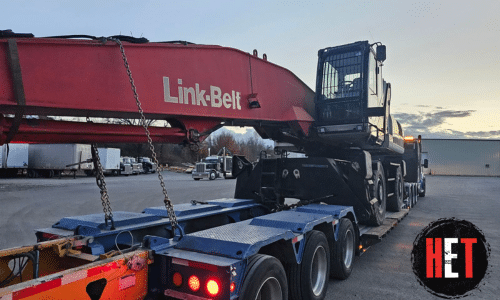Understanding the Costs of Heavy Equipment Shipping: Factors That Influence Pricing

William Thomas / January 2021
Shipping heavy equipment is essential in numerous industries, particularly construction, mining, and manufacturing. Transporting such equipment is no easy feat; it necessitates cautious planning, a focus on safety, and, in many cases, a significant financial commitment. As a result, understanding the expenses involved with this procedure is critical. It enables decision-makers to budget and prevent costly surprises successfully. This blog delves into the complexities of heavy equipment shipping prices to provide a clearer perspective for anyone navigating this complex terrain.
How Dimensions and Weight of Heavy Equipment Influence The Cost of Transport

“To eliminate unnecessary expenditures and ensure cost-effective transportation, rigorous inspection and knowledge of shipping quotes are essential.“
The size and weight of the equipment heavily influence shipping expenses. More significantly, heavier products require specialized shipping techniques, which increases logistical complications and costs. Because of the impact on infrastructure, such as roads and bridges, they may also necessitate additional permissions or incur higher prices.
Transporting oversized or heavy equipment presents several challenges, including:
• The need for specialized transport vehicles
• Navigating legal restrictions and obtaining necessary permits
• Managing potential infrastructure risks
• Ensuring safety while in transit
• Mitigating environmental impact
• Dealing with unpredictable weather conditions.

Transport Your Heavy Equipment Today
Heavy Equipment Transport is always available for a quote. Fill out the form or give us a call now! (888) 730-2951
Why The Equipment Type Influences Transport Pricing
Shipping prices vary depending on the type of equipment, such as bulldozers, cranes, or vehicles. Cranes, for example, may necessitate disassembly, resulting in increased expenses. Because bulldozers are large and heavy, they require specialized transportation, which raises the cost even more. Depending on their type and size, trucks may also have special transport requirements, influencing overall expenses.
How Distance and Location Affects The Cost of Transport
The shipping distance is directly proportional to the cost; longer hauls incur higher costs due to increased fuel consumption and wear and tear. Due to fewer accessible routes and infrastructure, shipping to remote locations frequently incurs significant expenditures. International transport, such as to Mexico or Canada, includes potential tariff prices, cross-border restrictions, and logistical challenges. Furthermore, the closeness of the end destination to a large port or transportation hub can influence expenses.
The Type of Trailer Required Affects The Cost of Transporting Equipment
The type of trailer chosen has a direct impact on shipping expenses. Flatbed trailers, adaptable and widespread, are generally inexpensive, but step decks can handle more oversized loads but are more expensive. Lowboy trailers, with their shallow ground clearance, may carry enormous equipment and, as a result, are more costly due to their specialized nature. Due to scarcity and the requisite handling experience, the need for bespoke trailers to transport specialist equipment dramatically raises costs.
Loading and Unloading Assistance Can Add To The Cost Of Shipping Your Equipment
The requirement for specialized loading equipment or employees can significantly increase transportation costs. This is especially true when working with large or sophisticated equipment requiring technical knowledge or apparatus for safe loading and unloading. Furthermore, disassembling and reassembling specific equipment at the shipping and receiving ends might incur significant labor and time expenditures, adding to the overall costs.
The Effect Of Seasonal and Market Demand On Transporting Your Equipment
Seasonal fluctuations can have a substantial impact on shipping charges. Peak demand for transportation services, for example, during vacation seasons or harvest months, might cause costs to rise. Rates may be lower during off-peak seasons. Market demand is also essential; a boom in demand can lead to higher prices, while a decline might lead to lower rates. This dynamic pricing allows shipping businesses to balance supply and demand successfully.

Fuel Prices Impact the Cost of Transporting Your Equipment
Fuel prices are naturally volatile, resulting in variable shipping costs. In this circumstance, fuel efficiency is critical. More fuel-efficient trucks require fewer refills, lowering overall expenditures. In contrast, if fuel prices rise, the increase is frequently passed on to customers, boosting shipping rates. As a result, the interaction between fuel costs and fuel efficiency considerably impacts final transportation costs.
The Need For Special Permits and Regulations Can Influence The price Of Equipment Transport
Special permissions for big loads can significantly increase transportation expenses. The cost and procedures for these permits differ per state, adding to the complication. State-specific restrictions may include route studies, escort cars, or distinctive signs, all contributing to the overall cost. These permits are required for safe and legal transportation, but their accompanying expenses can substantially impact pricing.
Insurance and Protection Impacts Equipment Shipping Costs
Insurance is essential to protect against damage or loss while transporting extensive equipment. However, this security comes at a cost that affects overall shipping costs. Insurance premiums are decided by the perceived risk and the value of the equipment, and higher rates can dramatically raise shipping costs. As a result, balancing proper protection with cost-effectiveness is a vital part of heavy equipment shipment.
The Price of Shipping Your Equipment Can be Affected By Additional Fees and Hidden Costs
Shipping quotations with hidden costs can dramatically increase the total shipping cost. Unexpected costs, including tolls, escort vehicle fees, and other unforeseen expenses, may appear after the initial price. These charges, which are sometimes underestimated, can significantly impact the budget. To eliminate unnecessary expenditures and ensure cost-effective transportation, rigorous inspection, and knowledge of shipping quotes are essential.
Various factors, including the equipment’s kind, weight, size, mode of transport, distance, and delivery location, impact heavy equipment shipping prices. Permits for excessive cargo, state-specific rules, insurance, and hidden fees such as tolls or escort vehicle charges can all add up. Thus, thorough research and collecting multiple quotations are critical to ensuring cost-effectiveness and avoiding unanticipated charges.

William Thomas
Heavy Transport Specialist
Being able to lead a team of such talented logistics agents has been a wonderful experience over the past ten years. If you would like to know anything more about the heavy equipment transport services we offer, don't hesitate to give us a call!